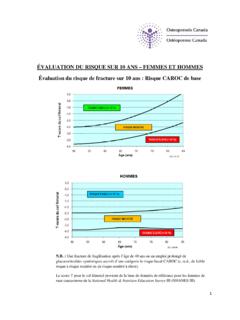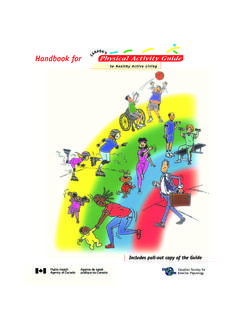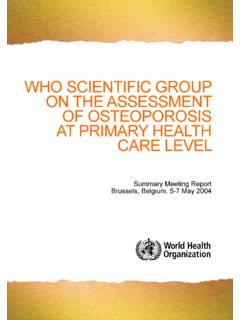Transcription of Burden of major musculoskeletal conditions - WHO
1 646 Special Theme Bone and Joint Decade 2000 2010 Bulletin of the World Health Organization 2003, 81 (9)IntroductionMusculoskeletal conditions are prevalent and their impact ispervasive. They are the most common cause of severe long-term pain and physical disability, and they affect hundredsof millions of people around the world. They significantlyaffect the psychosocial status of affected people as well astheir families and carers (1). At any one time, 30% ofAmerican adults are affected by joint pain, swelling, or lim-itation of movement (2). musculoskeletal conditions are adiverse group with regard to pathophysiology but are linkedanatomically and by their association with pain andimpaired physical function.
2 They encompass a spectrum ofconditions, from those of acute onset and short duration tolifelong disorders, including osteoarthritis, rheumatoidarthritis, osteoporosis, and low back pain. The prevalence ofmany of these conditions increases markedly with age, andmany are affected by lifestyle factors, such as obesity and lackof physical activity. The increasing number of older peopleand the changes in lifestyle throughout the world mean thatthe Burden on people and society will increase has been recognized by the United Nations and WHO,with their endorsement of Bone and Joint Decade2000 2010 (3).The Burden of musculoskeletal disorders can be meas-ured in terms of the problems associated with them, that isthe pain or impaired functioning (disability) related to themusculoskeletal system, or in relation to the cause, such asjoint disease or trauma.
3 The Burden should also be consid-ered in terms of who is at risk. A review of existing data as part of the Bone and JointMonitor Project in collaboration with WHO s global burdenof disease 2000 project recently identified the Burden ofmusculoskeletal conditions (4). Pain and disability associated with themusculoskeletal systemPain is the most prominent symptom in most people witharthritis (5), and is the most important determinant of dis-ability in patients with osteoarthritis (6). Self-reported per-sistent pain related to the musculoskeletal system has beenBurden of major musculoskeletal conditionsAnthony D. Woolf1& Bruce Pfleger2 Abstract musculoskeletal conditions are a major Burden on individuals, health systems, and social care systems, with indirect costsbeing predominant.
4 This Burden has been recognized by the United Nations and WHO, by endorsing the Bone and Joint Decade2000 2010. This paper describes the Burden of four major musculoskeletal conditions : osteoarthritis, rheumatoid arthritis,osteoporosis, and low back pain. Osteoarthritis, which is characterized by loss of joint cartilage that leads to pain and loss offunction primarily in the knees and hips, affects of men and 18% of women aged >60 years. Increases in life expectancyand ageing populations are expected to make osteoarthritis the fourth leading cause of disability by the year 2020. Jointreplacement surgery, where available, provides effective relief.
5 Rheumatoid arthritis is an inflammatory condition that usuallyaffects multiple joints. It affects of the general population and is more prevalent among women and in developedcountries. Persistent inflammation leads to joint destruction, but the disease can be controlled with drugs. The incidence may beon the decline, but the increase in the number of older people in some regions makes it difficult to estimate future , which is characterized by low bone mass and microarchitectural deterioration, is a major risk factor for fractures ofthe hip, vertebrae, and distal forearm. Hip fracture is the most detrimental fracture, being associated with 20% mortality and 50%permanent loss in function.
6 Low back pain is the most prevalent of musculoskeletal conditions ; it affects nearly everyone at somepoint in time and about 4 33% of the population at any given point. Cultural factors greatly influence the prevalence andprognosis of low back diseases/epidemiology/complications; Osteoarthritis/epidemiology/complication s; Arthritis Rheumatoid/epidemiology/complications; Osteoporosis/epidemiology/complications; Fractures/epidemiology; Low back pain/epidemiology/complications; Cost of illness; Risk factors (source: MeSH, NLM).Mots cl sAppareil locomoteur, Maladies/ pid miologie/complication; Arthrose/epidemiology/complications; Polyarthrite rhuma-to de/epidemiology/complications; Ost oporose/epidemiology/complications; Fracture/epidemiology; Lombalgie/epidemiology/complications; Co t maladie; Facteur risque (source: MeSH, INSERM).
7 Palabras claveEnfermedades musculoesquel ticas/epidemiolog a/complicaciones; Osteoartritis/epidemiolog a/complicaciones;Artritis reumatoidea/epidemiolog a/complicaciones; Osteoporosis/epidemiolog a/complicaciones; Fracturas/epidemiolog a; Dolorde la regi n lumbar/epidemiolog a/complicaciones; Costo de la enfermedad; Factores de riesgo (fuente: DeCS, BIREME).Bulletin of the World Health Organization 2003;81 page 654 le r sum en fran ais. En la p gina 654 figura un resumen en espa of Rheumatology, Peninsula Medical School, Duke of Cornwall Department of Rheumatology, Royal Cornwall Hospital, Truro TR1 3LJ, England(email: Correspondence should be addressed to this of Noncommunicable Diseases, World Health Organization, Geneva, includes both X-ray findings (9) and the presence ofjoint pain on most days (10), as either finding alone leads course of the disease varies but is often progressive:the radiographic changes of osteoarthritis progress inex-orably.)
8 Symptoms can be relieved and function improved,especially by joint replacement, but progression cannot beprevented and prevalenceFew data are available on the incidence of osteoarthritisbecause of the problems of defining it and how to determineits onset. Estimates from Australia indicate that the inci-dence of osteoarthritis is higher among women than menamong all age groups ( per 1000 population vs per1000) (11). For women, the highest incidence is amongthose aged 65 74 years, reaching approximately per1000 population per year; for men, the highest incidenceoccurs among those aged 75 years (approximately 9 per1000 population per year).
9 The prevalence of osteoarthritis increases indefinitelywith age, because the condition is not reversible. Men areaffected more often than women among those aged <45years, whereas women are affected more frequently amongthose aged >55 years (12). Worldwide estimates are that of men and women aged 60 years have symptomatic osteoarthritis(13). Radiographic studies of US and European populationsaged 45 years show higher rates for osteoarthritis of theknee: for men and for women (14). Surveysfocus on the tibiofemoral joint; osteoarthritis of thepatellofemoral joint has a major impact but is less radiographically proven osteoarthritis of theused in a number of population-based surveys to assess theprevalence of musculoskeletal conditions ; it affects up to20% of conditions cause more functional limi-tations in the adult population in most welfare states thanany other group of disorders.
10 They are a major cause of yearslived with disability in all continents and economies. In theOntario Health Survey, for example, musculoskeletal condi-tions caused 40% of all chronic conditions , 54% of all long-term disability, and 24% of all restricted activity days (7). Insurveys carried out in Canada, the USA, and WesternEurope, the prevalence of physical disabilities caused by amusculoskeletal condition repeatedly has been estimated at4 5% of the adult population (8). The prevalence is higheramong women and increases markedly with conditions are the main cause of disabilityamong older age groups. Moreover, the pain and physicaldisability brought about by musculoskeletal conditionsaffect social functioning and mental health, further dimin-ishing the patient s quality of life.
















